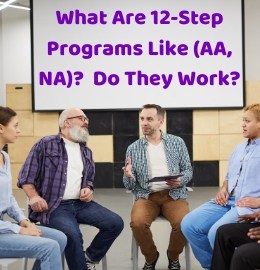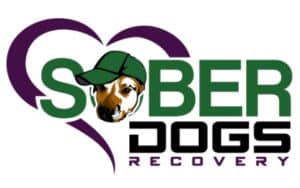
“Try it for 90 days, if you don’t like it we will glady refund your misery, the streets will always be there waiting if you choose”
This may seem harsh to some people but it’s %100 accurate. Many people are a mess when they first go to 12-step meetings. They have tried different things, and are in a mental and physical state of disarray. The whole point of the saying is to give it a try, what do you have to lose? If after 90 days you don’t feel like you’re getting anything then you can go back to your old way of life. Alcohol and drugs will always be waiting for you if you choose.
What Are 12- Step Programs?
12- step programs started in the 1930s with AA (alcoholics anonymous). 12- step programs’ basic purpose is to “help members stay sober and those members can carry the message to other alcoholics suffering and help them achieve sobriety”. 12-step programs are designed to allow members to come to terms with their addiction and what is causing these behaviors. The only requirement for membership is a desire to stop drinking. (substitute whichever word for sister fellowships e.g. The only requirement for GA is a desire to stop gambling). (Source) It has since branched out to multiple sister fellowships including but not limited to:
- Narcotics Anonymous (NA)
- Heroin Anonymous (HA)
- Cocaine Anonymous (CA)
- Marijuana Anonymous (MA)
- Gamblers Anonymous (GA)
- Overeaters Anonymous (OA)
- Sexaholics Anonymous (SA)
- Al-Anon (for friends and family or alcoholics)
- Nar-Anon (for friends and family of drug addicts)
12- step programs were created as a way for alcoholics to share their experience, strength, and hope with other alcoholics. It is designed for one alcoholic to take another through the twelve steps and then that person carries the message to someone else suffering from alcoholism. It has branched out at a rapid pace since the 1930s but has remained one of the most if not the most successful alcoholism and addiction treatment in history.
I have been in 2 county jails, 9 different prisons, 3 inpatient rehabs, 4 outpatient rehabs, and multiple other recovery events and programs and every one of these places use principles and teachings from 12-step programs, specifically AA.
What Are The Success Rates For 12-Step Programs?
Success rates for 12-step programs range from 50% – 10% depending on where you get your data. Accurate numbers for 12-step programs are nearly impossible to gather. Many of the people attending these meetings choose to remain anonymous which is why they only use their first name. This means outside companies trying to do surveys or research on any given 12-step program are not going to get information from everybody. Also one of the main principles of 12-step programs is to avoid outside issues. This means many 12-step meetings are very private and do not allow survey companies inside. These meetings don’t keep detailed stats on their members.
Along with those factors are time, location, sobriety length, and multiple other factors. Many rehabs will tout 95% success rates but when you look closer they are basing that on how many people graduated their program. The real test is not the 30-60 days someone is inside a secure rehab building. Its the next few years on the street with cravings, temptations, problems, life, death, breakups, emotions, and everything else life throws at us. Many people who attend certain 12-step meetings will switch their meetings up every year or move to a new city or go to a sister fellowship, none of these things means they relapsed but they may not be around a specific meeting.
All these factors make it nearly impossible to gather accurate success rates on AA and other 12-step programs. I look at the fact that AA is the longest-running and most consistent recovery program in the world with millions of members touting success.
AA’s Beginnings
AA was founded in Akron, OH in 1935 by a Wallstreet stockbroker named Bill Wilson (Bill W.) and an Akron

The breakout of WWII helped spread AA around the globe. Many men who attended AA in Ohio, New York, and a few other places around America in the late 1930s and early 1940s were sent off to fight when WWII started. They would create and form miny AA groups and meetings in the places they were stationed. This helped spread the message globally.
As of June 2015, there were 115,326 AA meetings in 175 different countries with over 2 million members. (source). That Number is just for AA if you include all the other programs branched out from AA like Narcotics Anonymous there are well over 8 million members worldwide.
What Are The Twelve Steps?

The 12-steps are the basic outline for the program of AA. Other 12-step programs like MA, HA, GA, and any other anonymous 12-step programs use the same steps they just substitute the word marijuana, heroin, gambling, Etc., for the word alcohol.
The 12-steps are the meat of the program. They are the main guide for finding a reprieve from drugs and alcohol. Going through the steps with a sponsor is what will help a person heal and stay sober. The steps are about finding those issues and traumas that caused you to drink or drug, working through them, and passing the message onto other alcoholics still suffering.
I know many men and women who are not addicts or alcoholics who have gone through the steps because they know how beneficial it has been for their lives. The 12-steps were designed to free people up from the burden and anxiety of living a life of lies, misery, and escaping feelings.
Are AA and other 12-Step Programs Religious Based?
12-step programs are not religious programs they are spiritual based programs. You will see the word God Multiple times in the steps. Many people judge this based on any past negative experiences with religion or the word God. God in the 12-steps is whatever your concept of God is. For some, it’s (Group Of Drunks) or (Good Orderly Direction). Your Concept of God or a higher power can be unique to you. Many non-religious people have found great success with 12-step programs and there is even agnostic’s an atheist’s who attends 12-step meetings.
I had and sometimes still have a very hard time wrapping my head around the word and concept of GOD. Over my time in 12-step meetings, I have come to find my own view of a higher power, one that is not a punishing fire and brimstone GOD. I had to put my past experiences with religion aside to truly have an open mind. For many, their higher power is simply AA meetings itself. My first sponsor made it really simple for me he said:
“Do you believe that these 20 alcoholics in this meetings all working together for a common good is a power greater than just you?”
I said yes and that was all I needed to believe in.
The 12-Traditions – Long-Term Success
The most important part of AA’s long-term success is its traditions. The traditions were put into words around 1944 when AA meetings were expanding around the country and world. There were some internal problems with AA and it’s members so the twelve traditions were designed to hold AA together. The point of the twelve traditions is to set guidelines for how groups interact with each other, members, and society at large. The traditions set rules for promotion or lack thereof, donations, finances, and members’ roles and positions.

Tradition 10 states: “Alcoholics Anonymous has no opinion on outside issues; hence the AA name ought never be drawn into public controversy”
I believe this tradition is one of the most important parts of the entire program. AA and it’s founders have gone to great lengths over the years to maintain a neutral stance on politics, religion, public controversies, and other societal drama. This has allowed AA to keep a clean and clear name and shows the true purpose is to help people struggling not to push a hidden narrative.
At the meetings I go to there are people of every race, religion, gender, ethnicity, and background. People with polar opposite political views will sit next to each other and work together. These traditions have allowed AA to weather many storms over the years.
How Do I Become A Member of AA or Another 12-step Program?
The only requirement for AA is a desire to stop drinking. Same with other 12-step programs. The majority of meetings are held at public places like churches, community centers, and schools. Open meetings are for anyone to attend: alcoholics, friends, family, or just someone curious about the program. Closed meetings are usually reserved for AA members or people wishing to become members. There are no age restrictions for 12-step programs and people of any gender, background, ethnicity, or religion can attend.
There are no dues or fees to become a member of AA or other 12-step programs. During 12-step meetings they will pass around a basket and if you choose to you can put a dollar or two in. Many people can’t afford this and that’s fine. It has no effect on their ability to stay or continue to attend meetings and work the program. The money collected goes to a number of expenses including rent, literature, coffee, food, cups, chairs, repairs, and anything else the meetings may need.
-Kyle Ruggeri –
Sources:
https://www.addictioncenter.com/treatment/12-step-programs/
https://www.alcohol.org/alcoholics-anonymous/

